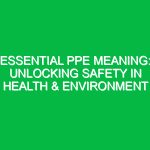Introduction
Personal Protective Equipment (PPE) protection is a cornerstone of health, safety, and environmental (HSE) management. It refers to the equipment worn to minimize exposure to Hazards that can cause serious workplace injuries and illnesses. The relevance of PPE in the HSE domain cannot be overstated, as it serves as the last line of defense against workplace Hazards. In industries ranging from construction to healthcare, the right PPE can mean the difference between Safety and risk.
In this article, we will explore the critical aspects of PPE protection, examining its components, benefits, best practices, and the Regulations governing its use. By understanding the importance of PPE protection, organizations can foster a culture of Safety that prioritizes employee health and environmental Sustainability.
The Key Components of PPE Protection
Types of PPE
PPE encompasses a wide variety of equipment designed to protect workers from specific hazards. Here are some essential categories of PPE protection:
- Head Protection: Hard hats are vital in construction and manufacturing settings to shield against falling objects and head injuries.
- Eye and Face Protection: Safety Goggles and face shields protect against chemical splashes, flying debris, and radiation.
- Respiratory Protection: Masks and respirators are essential in environments with airborne contaminants, such as dust, fumes, or viruses.
- Hand Protection: Gloves made of various materials safeguard against cuts, abrasions, chemical exposure, and thermal hazards.
- Foot Protection: Steel-toed boots and non-slip shoes prevent injuries from heavy objects and slips, respectively.
- Body Protection: Coveralls, aprons, and vests protect employees from hazardous materials and extreme temperatures.
Each type of PPE is tailored to specific tasks and environments, making it crucial for employers to assess workplace hazards and select appropriate equipment.
Understanding Workplace Hazards
To effectively implement PPE protection, it is imperative to understand the nature of workplace hazards. Hazards can be categorized into several types:
- Physical Hazards: These include slips, trips, falls, and exposure to machinery.
- Chemical Hazards: Employees may encounter harmful substances, including corrosive materials, solvents, and gases.
- Biological Hazards: This category includes exposure to bacteria, viruses, and other pathogens, particularly in healthcare settings.
- Ergonomic Hazards: Poor workplace design can lead to repetitive strain injuries and musculoskeletal disorders.
Identifying these hazards through regular risk assessments allows organizations to select the right PPE and implement effective safety protocols.
The Benefits of PPE Protection in HSE
Implementing proper PPE protection offers numerous benefits that extend beyond mere compliance with regulations:
- Reduction in Workplace Injuries: Effective use of PPE significantly lowers the risk of injuries and illnesses, creating a safer work Environment.
- Increased Employee Morale: When employees feel safe, their job satisfaction and productivity often improve, fostering a positive workplace culture.
- Cost Savings: Fewer accidents lead to lower medical expenses, reduced insurance premiums, and decreased absenteeism.
- Regulatory Compliance: Adhering to PPE regulations ensures that organizations avoid fines and legal issues.
By prioritizing PPE protection, organizations can cultivate a culture of safety that benefits both employees and the organization as a whole.
Best Practices for PPE Protection
To maximize the effectiveness of PPE protection, organizations should implement the following Best Practices:
Conducting Regular Training
Training is essential for ensuring that employees understand the proper use of PPE. Regular training sessions should cover:
- The importance of PPE in preventing injuries.
- How to properly wear and maintain PPE.
- When to use specific types of PPE based on hazards.
Real-life experiences shared by employees during training can enhance understanding and engagement, making the training more impactful.
Establishing a PPE Program
A comprehensive PPE program should include:
- Hazard assessment Procedures to identify necessary PPE.
- Selection criteria for appropriate PPE types.
- Maintenance and replacement protocols to ensure PPE remains effective.
- Documentation and record-keeping for compliance and safety audits.
This structured approach ensures that all Safety Measures are consistently applied.
Encouraging Employee Feedback
Creating an open dialogue about PPE protection allows employees to express concerns or suggestions regarding their Safety Gear. Engaging employees in discussions about their experiences helps identify potential areas for improvement and fosters a sense of ownership over their safety.
Potential Hazards and Safety Considerations
While PPE protection is vital, it is essential to recognize that it does not eliminate hazards. Instead, it serves as a protective barrier. Employees must be aware of potential limitations and ensure that PPE is used in conjunction with other Safety Measures, such as engineering controls and administrative practices.
For instance, wearing a respirator does not replace the need for proper ventilation in a workspace. Similarly, hard hats are crucial for preventing head injuries but do not negate the importance of maintaining a tidy work area to prevent slips and falls.
Regulations and Standards Governing PPE Protection
PPE protection is governed by various regulations that ensure Workplace Safety. In the United States, the Occupational Safety and Health Administration (OSHA) sets forth standards that require employers to provide appropriate PPE to employees exposed to hazards. Key standards include:
- 29 CFR 1910: General Industry Standards, which outline PPE requirements for various industries.
- 29 CFR 1926: Construction Standards focusing on PPE for construction workers.
- ANSI/ISEA Standards: These voluntary consensus standards provide guidelines for the design, performance, and testing of PPE.
Compliance with these regulations not only protects employees but also mitigates legal risks for employers.
Conclusion
In conclusion, PPE protection is an essential element of health, safety, and environmental management. By understanding the various types of PPE, recognizing workplace hazards, and adhering to Best Practices, organizations can create a safe working environment that prioritizes employee health and well-being.
The importance of PPE protection extends beyond compliance; it fosters a culture of safety and responsibility. As we continue to navigate complex work environments, let us prioritize the health and safety of our workforce by implementing effective PPE measures. By doing so, we not only protect our employees but also contribute to a sustainable and safe working world for everyone.


